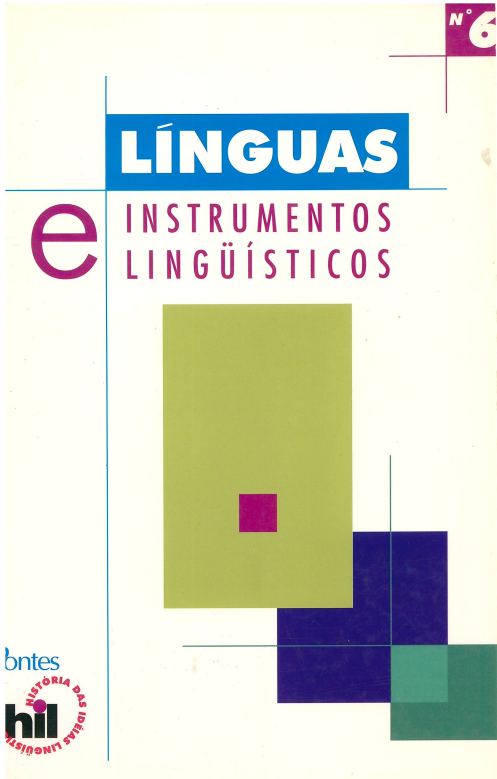Abstract
Most current lexical models treat at least part of phonothatics, i.e., syntax of phonic units (whether sequential or not), by means of derivational rules. In the radically non-derivational approach advocated here, the wellformedness conditions explanings neologisms also also apply to existing forms, which must be listed in the lexicon regardless of productivity. A novelty about such restrictions is their probabilistic nature. They are expressed in quantitative terms and take into account factors such as the frequencies of occurrence of the units in question and the rightward or leftward directions of the relations among them. The discussion is supported by probabilistic phonotatic data from Brazilian Portuguese, including morphophonology.
References
ALBANO, E. (no prelo). O gesto e suas bordas: esboço de fonologia acustica-articulatoria do portugues brasileiro. Campinas: Editora Mercado de Letras.
ALBANO, E. 1999a. criatividade e gradiência num lexico sem derivações. In: Grimm-Cabral e J. Morais (orgs.). Investigando a Linguagem: ensaios em homenagem a Leonor Scliar-cabral. Florianopolis: Editora Mulheres, pp. 35-54.
ALBANO, E. 1999b. O gesto articulatorio como unidade fonica abstrata: indicios da fala infantil e evidencias da fala adulta.. In: R, Lamprecht (org.). Aquisição de linguagem: questões e analises. Porto Alegre. Editora da PUC-RS, pp. 139-163.
ALBANO, E. 1999c. A gestural solution for some glide epenthesis problems, Procedings ICPhS'99. Berkeley: University of Californa at Berkeley, vol 3 : 1785-1788.
ALBANO, E. 1999d. "Representações fonetica e fonologia: ruma a parcimõnia". Cadernos de Estudos Linguisticos, 37, no prelo.
ALBANO, E; P. Barbosa.; S. Madureira; A Gama- Rossi; A. Silva. 1998. A interface fonetica-a-fonologia e a interação prosodia-segmentos. Estudos Linguisticos XXVII: anais dio XLV Seminario do Grupo de Estudos Linguisticos do Estado de São Paulo (GEL). São Jose do Rio Preto: UNESP- IBILCE, 135-143.
BARBOSA, P. 2000. Timing in Brazilian Portuguese revisited: new light under a dynamical perspective. Manuscrito inedito. LAFAPE, IEL, UNICAMP.
BERKO, J. The childs learning of English morphology. In: S. Saporta (org.) Psycholinguistics: a book of readings . Nova Yorque: Holt, Rinehart and Winston, 1961, pp. 359-375.
BROWMAN, C.;L. Goldstein. 1985. Dynamic Modeling of phonetic structure. In V.Fromkin (org.). Phonetic Linguistics. Nova Iorque: Academic Press, 35-53.
BROWMAN, C.; L. Goldstein. 1989. Articulatory gestures as phonological units. Phonology Yearbook 6: 201-251.
BROWMAN, C.; L. Goldstein. 1990a. Tiers in articulatory phonology. In: Kingston e Beckman, pp. 341-376.
BROWMAN, C.; I Goldstein. 1990b. Gestural specification of dynamically determind articulatory structures. Journal of Phonetics, 18: 299-320.
BROWMAN, Goldstein.. 1992a. Articulatory phonology: an overview. Phonetica, 49: 155-180.
BROWMAN, C.; L. Goldstein. 1992b. "Targetless" schwa: an articulatory analysis. In: G. Docherty e R.ladd (orgs.), pp. 26-56.
DELL, G. 1998. The retrieval of phonological forms in production: tests of predictions from a connectionist model. Journal of Memory and Language, 27: 124-142.
DOCHERTY, G.; R. Ladd. 1992. (orgs.). Papers in laboratory phonology II: gesture, segment,prosody, Cambridge: Cambridge University Press.
FERREIRA, A.B.H. s. d. Dicionario Aurelio. Rio de Janeiro: Nova Fronteira.
FERREIRA, A.B.H. 1977. Minidicionario Aurelio. Rio de Janeiro: Nova Fronteira
FRISCH, S.; R. Wright. 1998. THe phonetics of phonological speech errors: abn acoustic analysis of /s/ and /z/ errors by four talkers. Research in spoken language processing: Progress Report 22. Bloomington: Indiana University Speech Research Laboratory, pp. 125-154.
GAMA-ROSSi, A. 2000. A realidade psicologica da fonotaxe do português brasileiro e o estatuto das represetações lexicais. Projeto de pesquisa de pos-doutorado aceito pela FAPESP.
KINGSTON, J.; M. Beckman. 1990. (orgs.). Papers in laboratory phonology: between the grammar and the physics of speech . Cambridge: Cambridge University Press.
KIPARSKY,P. 1982. From Cyclic phonology to lexical phonology. In: H. vander Hust e N. Smith (orgs.). The structure of phonological representation. Part I. Dordrecht: Foris, pp. 131-175.
KELSO, J; E. Saltzman; B. Tuller. 1986. The dynamical perspective on speech pro junction: data and theory. Journal of Phonetics, 14 : 29-59.
NAVAS, A.L. 2000. Estudo experimental sobre a natureza da representação fonologicas. Relatorio de pesquisa de pos-doutorado submetido a FAPESP.
PACHECO, V. 2000. Estudo fonetico acustico da inserção de glide(1) diante de (s) de cada num corpus de noticiarios televisivos. Relatorio de pesquisa de iniciação cientifica. CNPq, PIBIC-UNICAMP.
PIERREHUMBERT, J. 1993. Dissimilarity in the Arabic verbal roots. Procedings of the north east linguistic society, 23: 367-381.
PRINCE, A.; P, Smolensky. 1993. Optimality theory: constrain interaction in generative grammar. Manuscrito inedito: Rutgers University e University of Colorado.
RAVIZZA, J. 1956. Gramatica Latina, Niteroi: Fundação Dom Bosco.
SCLIAR-CABRAL, L.; M. Kuhn, 1976. Adaptação do teste de BerkoGleason de morfologia ao português. Comunicação a SBPC, Brasilia.
WHALEN, D.; C. Best; J. Irwin. 1997. Lexical effects in the perception and productionof American /p/ allophones. Journal of Phonetics, 25, 501-528.

This work is licensed under a Creative Commons Attribution-NonCommercial-ShareAlike 4.0 International License.
Copyright (c) 2001 Línguas e Instrumentos Línguísticos


